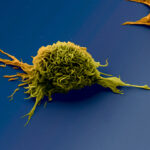Link to Pubmed [PMID] – 10603395
Infect Immun 2000 Jan; 68(1): 247-56
Bordetella pertussis adenylate cyclase (AC) toxin-hemolysin (ACT-Hly) can penetrate a variety of eukaryotic cells. Recombinant AC toxoids have therefore been recently used for delivery of CD8(+) T-cell epitopes into antigen-presenting cells in vivo and for induction of protective antiviral, as well as therapeutic antitumor cytotoxic T-cell responses. We have explored the carrier potential of the ACT molecule by insertional mutagenesis scanning for new permissive sites, at which integration of two- to nine-residue-long peptides does not interfere with membrane interaction and translocation of ACT. A model CD8(+) T-cell epitope of ovalbumin was incorporated at 10 of these permissive sites along the toxin molecule, and the capacity of ACT constructs to penetrate into cell cytosol and deliver the epitope into the major histocompatibility complex (MHC) class I antigen processing and presentation pathway was examined. While all six constructs bearing the epitope within the Hly portion of ACT failed to deliver the epitope to the MHC class I molecules, all four toxoids with inserts within different permissive sites in the AC domain efficiently delivered the epitope into this cytosolic pathway, giving rise to stimulation of a specific CD8(+) T-cell hybridoma. The results suggest that, in contrast to the AC domain, the hemolysin moiety of ACT does not reach the cytosolic entry of the MHC class I pathway.

